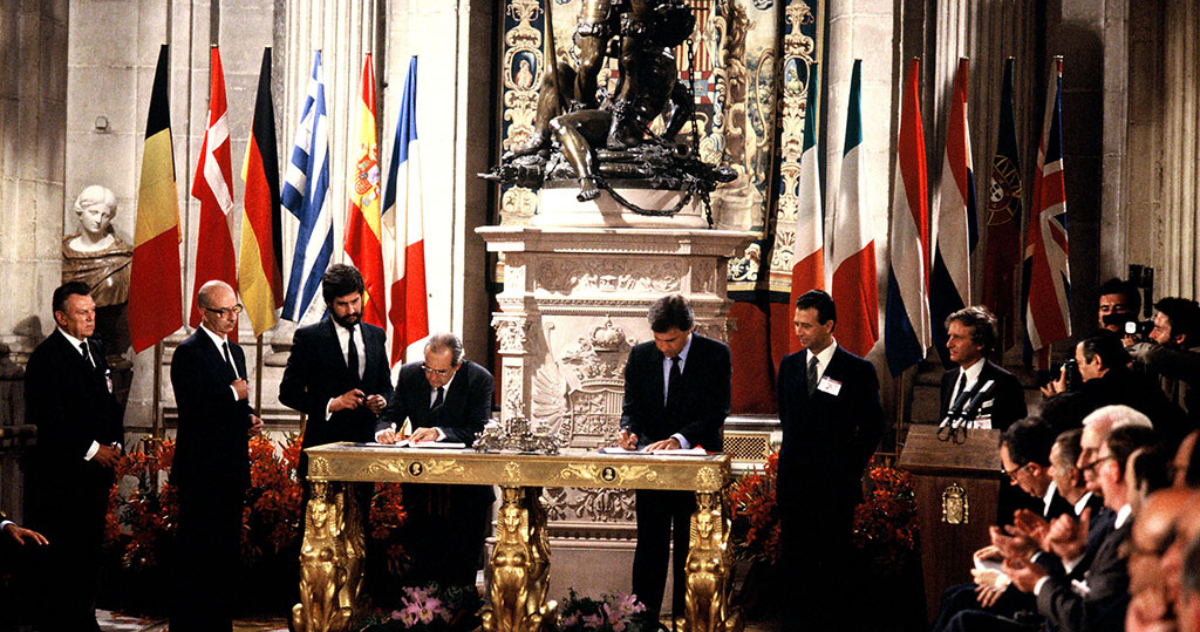Europe (Parliament Politic Magazine) – On June 12, 1985, Felipe Gonzalez, who served as the President of the Spanish government, signed the Treaty of Accession at Madrid’s Palacio Real. He was joined by the Foreign Minister, Fernando Moran, and Manuel Marin, who held the position of Junior Minister for Relations with European Communities.
Fernando Moran (1926-2020), who had a background as an author and diplomat prior to his role as Foreign Minister from 1982 to 1985, played a crucial role in laying the groundwork that ultimately paved the way for Spain’s accession to the European Economic Community. At the time of Spain’s entry, the European Economic Community consisted of ten member states.
Fernando Moran Presented Details of Negotiations
On March 29 of that year, Fernando Moran presented the details of his negotiations in Madrid to a plenary session of the national parliament in the Spanish capital.
“Our history is in Europe and outside Europe, but we shall all be part of Europe,” he revealed to MPs.
“Spain will put an end to the historic inferiority complex that has caused its isolation and it will definitively regain its course and role in Europe. “I take for granted everybody’s European vocation and favorable support for our negotiating position in the last stage of the negotiations.”
Following the endorsement of their plans to join the European community by members of parliament from various political parties, Fernando Moran and Manuel Marin were granted an audience by King Juan Carlos I and Queen Sofia. On the same day, Felipe Gonzalez had also met with the royal couple.
The following day, on March 30, the Council of Ministers of the European Economic Community (EEC) approved Spain’s application for membership. This decision came after precisely eight years and three hours of negotiations had transpired, beginning with the formal application made by then-President Adolfo Suarez to the EEC in 1977.
Signing Accession Treaty on June 12, 1985
After the signing of the Accession Treaty on June 12, 1985, Spain formally became a member of the European Economic Community (EEC) on January 1 of the following year, concurrently with Portugal. This expansion brought the total number of EEC member countries to 12.
Spain’s journey toward EEC membership began much earlier, with an initial expression of interest dating back to February 9, 1962. At that time, the Spanish Foreign Minister, Fernando Maria Castiella, sent a letter to Maurice Couve de Murville, who served as the President of the Council of Ministers of the EEC, indicating Spain’s eagerness to engage with Europe.
In Castiella’s letter, he emphasized Spain’s “European vocation,” its strategic geographic location, and its economic interests. He expressed the hope that Spain would be able to align its economy with the conditions of the Common Market (EEC).
It’s important to note that the EEC’s reception may have been more favorable had Spain been a democracy at the time, as it was then governed by General Francisco Franco’s dictatorship. In response to Castiella’s letter, Maurice Couve de Murville’s reply from the EEC was rather brief and consisted of an acknowledgment of receipt, which was received in Madrid on March 6.
Read More: Record Windstorm Ciaran Claims 10 Lives in UK and Western Europe
Spain’s Integration in EEC
While there were initial contacts in 1964 and 1966, progress toward Spain’s integration into the EEC was limited. It wasn’t until after the death of General Francisco Franco in 1975 and the subsequent transition to democracy in Spain that significant strides were made in this regard. During this period of political change, Spain’s path to EEC membership began to gain momentum.
The signing of the Treaty of Maastricht in 1992 marked a significant milestone for the European Union (EU), as it not only gave the EU its current name but also outlined a path towards the creation of a common currency. In the same year, at the Edinburgh Summit, Member States introduced the Cohesion Fund, aimed at financing projects related to the environment, transportation infrastructure, and energy in countries with income levels lower than 90% of the EU average. Spain benefited significantly from this fund, receiving vital support for economic revitalization and regional development, in addition to other structural funds.
Spain has actively contributed to the development of the European project, participating in the negotiation of various treaties, including the Treaties of Amsterdam (1997), Nice (2001), and Lisbon (2009), as well as the Draft Treaty establishing a Constitution for Europe (2004).


